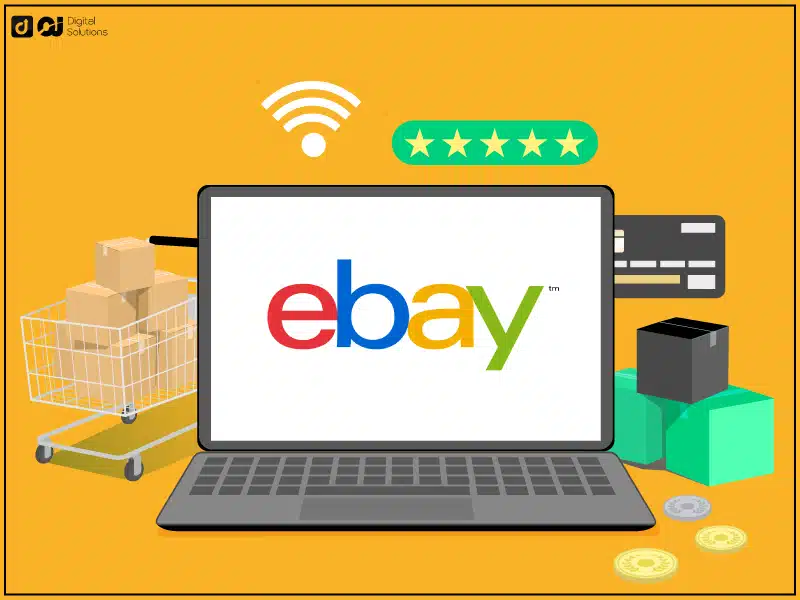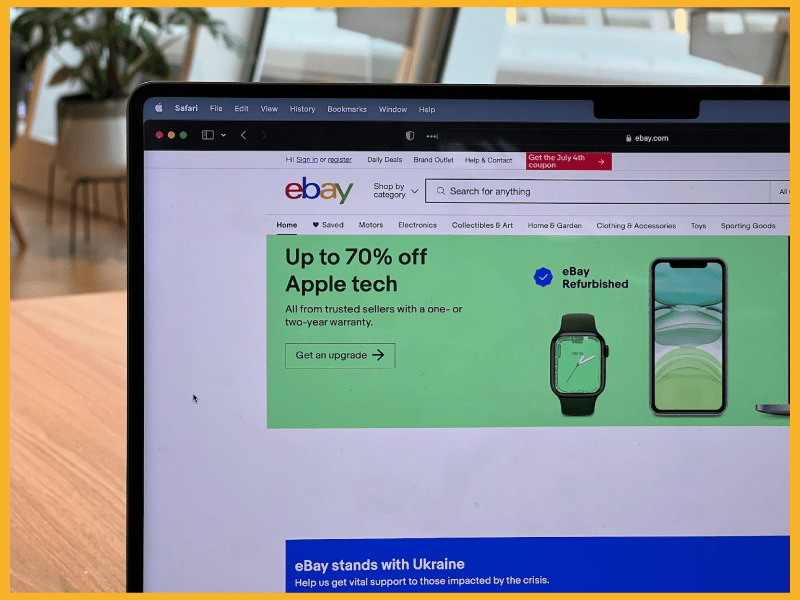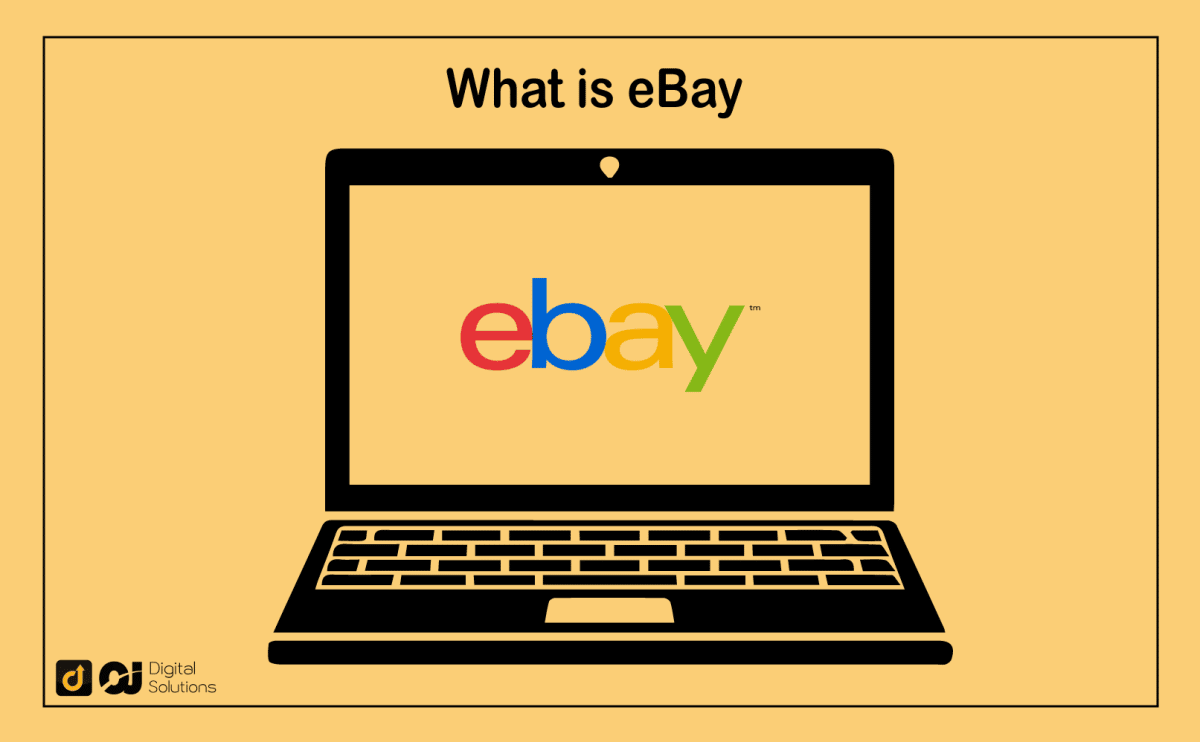Have you asked yourself, “What is eBay?”
If so, you’ve come to the right place.
My guide will discuss everything you need to know about eBay. I will provide information on the following:
- What eBay is
- What an eBay store is
- The benefits of selling on eBay
- The downsides of selling on eBay
- and more
Let’s begin!
An Introduction to eBay
Pierre Omidyar founded eBay in San Jose, California, in 1995, making it one of the earliest ecommerce platforms. Omidyar’s consulting firm was the initial owner of the site.
Omidyar’s attempt to register the domain name echobay.com in 1997 was unsuccessful because a gold mining company called Echo Bay Mines already owned it. He decided to modify the name to eBay.com.
Have you ever wondered what does the e in eBay stand for?
A general misconception is that the “e” in eBay stands for “electronic.”
It actually stands for “Echo,” and the name eBay means Echo Bay Technology Group.
The primary goal was to bring together millions of buyers and sellers worldwide to purchase and sell new and used goods. eBay may have had different names throughout its history, but its fundamental concept is the same.
The company still relies heavily on the model that Omidyar developed in 1995. The company’s guiding objective and principle is to make affordable goods and services available worldwide.
As a result, eBay has gained a tremendous global following. Many buyers find the auction listing feature alluring, particularly those who own or are interested in buying rare collectible items.
The fact that collectors can find things on eBay that they can’t find elsewhere has made the platform immensely popular.
As of 2022, the eBay marketplace has more than 1.6 billion active listings and over 138 million active buyers worldwide.
What Is eBay?

eBay is an online marketplace where people buy and sell items. Online merchants (including individual sellers) put up items for sale and allow buyers to participate in online auctions to purchase those items.
Buyers go to eBay to search for items they want to buy. When they find an item they want, they can bid for it through eBay’s online auction capabilities.
In addition to an extensive selection of items, eBay provides buyers with convenient shipping alternatives and speedy delivery service at no additional costs. eBay also provides status updates for orders.
Regarding sellers, eBay provides them with a massive pool of potential buyers.
Sellers also have two options for selling:
- Buy It Now (fixed-price listings)
- Bidding (auction-style listings)
eBay’s Top Rated Seller Program rewards sellers who go above and beyond customers’ expectations and have a fair returns policy.
What attracts buyers and sellers to eBay is that an item is only worth what someone is willing to pay.
Sellers can charge high prices for in-demand products, such as vintage items, collectibles, unique items, appliance parts, and pre-owned or refurbished products no longer in production.
What Is the History of eBay?
When Pierre Omidyar first started eBay in 1995, it was a part of a more prominent personal website. eBay was originally called AuctionWeb.
One of the first items sold on AuctionWeb was a broken laser pointer.
The buyer was a collector and was aware the laser pointer didn’t work. Word soon spread about an online auction site where people could sell unwanted items. It was then that AuctionWeb’s popularity skyrocketed.
What started as a hobby for Omidyar grew so much that he had to update his internet plan to a corporate account due to high web traffic, increasing his monthly fee from $30 to $250.
He started charging AuctionWeb users to afford his internet fees. Despite the charges, sellers continued to use eBay.
In September 1997, the company formally changed from AuctionWeb to eBay.
What Type of Platform Is eBay?

Individuals can sell new and used products on eBay to get rid of pre-owned items and make money.
eBay is an online marketplace that facilitates business-to-business and consumer-to-consumer (B2C and C2C) electronic transactions.
The platform also facilitates the sale of tickets for live events through StubHub, a company eBay acquired.
Buyers on eBay can choose from various options:
- Product condition – New or used
- Shipment method – International shipping, free or paid
- The Buy it Now section helps shoppers find an item.
- The Deals option displays all the sales happening that day.
eBay enables individuals to buy and sell products in 180 countries worldwide.
Sellers list items for sale and include photos, descriptions, prices, and delivery information.
Meanwhile, auction items have a starting bid price, payment methods, and bidding duration.
eBay offers sellers a specific amount of free listings monthly, depending on their subscription plan. eBay charges sellers a fee for each extra listing after they’ve used all their free listings.
eBay makes money from each sale, whether it’s a free or paid listing. Registered eBay sellers pay a reduced final value fee on every sale.
The platform is a user-friendly online ecommerce site. Buyers can access it through the website or the eBay app. They get to compare different sellers’ prices and choose the products they prefer the most.
Various delivery options are available to sellers on eBay. However, certain sellers only offer one shipping method.
For instance, surface mail shipping can take one to two months for low-value items from China. If buyers need their order immediately, they can pay for faster shipping options such as first-class airmail or second-class surface mail.
The feedback option allows buyers and sellers to rate their experiences. These ratings appear on buyers’ and sellers’ profiles and affect how others in the eBay ecosystem view them.
eBay has different standards and regulations depending on the product or service to protect everyone’s interest during a transaction.
The platform is also well-known for its commitment to increasing user loyalty through daily deals and quick and straightforward payment transactions.
What Does eBay Do?
eBay enables millions of buyers and sellers worldwide to interact and do business. Regardless of a seller’s location, the platform’s technology allows them to expand their businesses and succeed.
What Type of Business Is eBay?
eBay is an online shopping site where people can see items for sale.
eBay makes it easy for sellers to list items on the marketplace and make money. It actively encourages sellers to join its auction marketplace and provides them with different avenues to sell their goods, such as the eBay store or eBay Classifieds.
eBay imposes two distinct fees on sellers.
Insertion Fee
Sellers can take advantage of up to 200 free listings monthly. Sellers with an eBay store could get more.
eBay charges sellers a listing insertion fee for each listing after they use all their free listings. eBay doesn’t refund this fee if the item doesn’t sell.
Each listing has a single insertion fee, regardless of its category. If an auction-style listing sells, eBay gives the seller a fee credit.
Final Value Fee
eBay charges a final value fee whenever sellers make a sale. Overall sales determine the cost of this fee.
Here are other charges that may apply.
Advanced Listing Upgrade Fees
eBay charges a per-upgrade fee if sellers want to add advanced listing enhancements, which are listing additions not included in the initial insertion fee.
Supplemental Service Fees
eBay charges additional fees for things like shipping labels printed directly from the website and money refunded to eBay via buyer refunds.
What Is an eBay Store?

You can reap the benefits of the eBay marketplace and its millions of buyers worldwide by opening an eBay Store.
An eBay store is a complete ecommerce solution. You gain access to unique branding, marketing tools, and powerful personalization options that can help you attract customers and build loyalty.
You can showcase all your items in one place, giving customers quick access to information about your business and products.
eBay sellers also gain access to various tools with the eBay Store subscription package. A seller gets fixed-price listings with traditional advertising and auction-style listings with reduced Final Value fees.
You can notice an eBay store by the red “Stores” tag next to the user ID.
Opening an eBay Store
Everyone with a Seller Account needs to pay a subscription fee. You can’t run your shop without paying eBay’s subscription fees.
Sellers are free to select the subscription plan that best matches their requirements. Many enterprise-level sellers can save substantial money because their upfront payments are lower.
You will have access to powerful tools that can assist you in creating, managing, advertising, and tracking your eBay account to boost sales.
Here are the requirements for opening an eBay store.
- An eBay seller account with a valid credit card on file
- A Paypal-verified account
- A seller rating above the industry standard ( if you want a Premium or Anchor store)
If you have the above requirements, the next step is to choose your ideal subscription plan. Here’s how.
- Navigate to the My eBay and go to your Account page.
- In the Selling menu, select Subscriptions.
- Select the plan you want and click Select and review.
- Check the subscription package details before making your decision.
- Choose the billing of your Store Subscription (monthly or annually).
- Click the Submit order button.
Listing Items on eBay Store
Here’s how to start listing items on your eBay store.
- Navigate to Seller Hub and click on Listings.
- Click Create Listing under the Listings button.
- Describe what you are selling on eBay and click the Search button.
- Fill in the item details.
- Type in the item description.
- Fill in additional information.
- Specify your delivery terms
- Enhance your listings at an extra cost (optional).
- Provide details on payment methods, returns, and item location.
- Check the bottom of the page to see the total fees. You don’t have to pay listing costs if you see “List it for free.”
- Click the Preview button to see how your listing appears on eBay.
- Click List it if you don’t need to edit anything.
Maximize your eBay store’s About Me page and tell potential buyers about yourself, your interests, and your goals on eBay. You can add a direct link to your e-commerce store on this page.
Promote your store further by including leaflets for your ecommerce store in the packages you ship to your eBay customers.
How to Grow Your eBay E-Commerce Store
Here are strategies you can implement to increase your chances of success on eBay.
Offer Discounts and Coupons.
If you want to boost eBay sales and encourage repeat business, include promo codes in your shipments. Your customers will be more willing to order from your store again if you offer discounts.
Take a Customer-Focused Approach.
Look at your store from your customer’s perspective. Consider the factors that would compel you to make purchases if you were the shopper.
Prioritize Your Buyers’ Needs.
Consider your buyers’ feedback to distinguish yourself in the marketplace. Prioritize your buyers’ interests and create personalized marketing plans.
Consider Your Profit Margin.
eBay charges fees for selling on the platform, which can deter sellers who offer low prices for their items.
You need to consider your profit margin and ensure eBay’s fees don’t eat into it.
Reasons for eBay Account Suspension
You can be successful on eBay, but you can also set yourself up for failure and an account suspension.
Here are reasons why eBay might suspend your seller account.
Payment Issues
eBay may suspend your account if your payment details are outdated or if you owe any payments (eBay seller fees, outstanding refunds to buyers).
Unresolved Buyer Conflicts
Resolve issues with customers as soon as they express dissatisfaction with an item. eBay created the Seller Resolution Center for such situations.
Do your best to compromise with a buyer regardless of how irrational they may seem. You can always report and block unethical buyers on eBay.
Missing or Delayed Tracking Number
It can frustrate eBay buyers when you don’t upload the tracking number or are late in doing so. Keeping buyers happy requires acting promptly.
Shady Practices
eBay will ban your account for unethical practices like selling defective or used items as new. Never use deceptive language or techniques to boost sales.
Late Delivery
eBay prioritizes prompt delivery.
Buyers look at the expected delivery date before buying, so ensure you follow through.
If you promise to deliver something within one week, keep your word.
Delayed shipping can result in poor seller ratings and an account suspension.
Benefits of Selling on eBay
Here are reasons to sell on eBay.
High Amount of Traffic
Over 160 million people use eBay. Use this traffic to your advantage and sell items to millions of potential buyers worldwide.
Unique Selling Alternative
As an ecommerce platform, eBay is unique because it offers an auction-selling option in addition to its regular buying option.
Do you have books, toys, or clothes you don’t need? Declutter your home and list your pre-owned item’s on eBay auction.
Easy to Start
It’s much easier to create an eBay storefront than to build your e-commerce store from the ground up.
To start on eBay, you only need to create a seller account and pay a subscription.
Easy to Manage
You can personalize your storefront to your liking. Then, you can start adding items. eBay makes setting up an e-commerce business easy.
Efficient store management is now possible for eBay sellers with the help of a dedicated mobile app.
eBay Community Support
The eBay community is a fantastic asset. You can learn how other successful sellers expanded their e-commerce store and apply those lessons to your business. Read eBay discussion boards to get expert advice from other sellers.
Convenience
eBay is convenient for buyers because they use the platform to shop online. Therefore, you’ll always have a massive pool of potential buyers you can turn into paying customers.
Seller Protections
eBay has policies to protect sellers when customers fail to pay for an item or file a Money Back Guarantee claim without providing evidence that the seller did anything wrong.
Disadvantages of Selling on eBay
Not Much Freedom
You must follow eBay’s rules and regulations to continue selling on the platform. Any infractions can result in an account suspension or a permanent ban.
Priority for Particular Sellers
The same-day delivery incentive is excellent for sellers who can accomplish it. Those who can’t are at a disadvantage. eBay won’t prioritize your shop if you can’t deliver items promptly.
Not Ideal for High-End Selling
Many people who visit eBay want to save money. These buyers often go for the cheapest option. As such, there may be better platforms to sell high-end items.
The Bottom Line
Hopefully, my article has given you a clearer picture of how eBay works and how you can use the platform to your advantage when selling.
Don’t be afraid to start your journey selling on eBay today. The platform is a fantastic starting point if you want to try your luck at e-commerce selling.
Visit my blog for more ecommerce tips and strategies.




